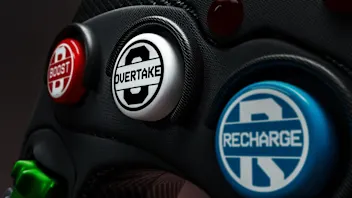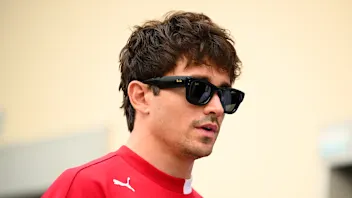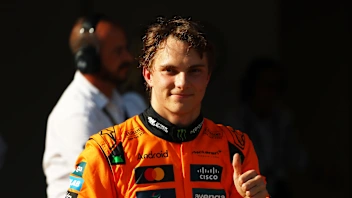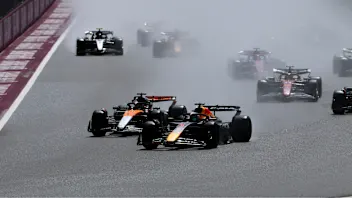As the enforced mid-summer shutdown approaches, the Hungarian Grand Prix weekend is likely to be just as tough as Russia was last year for drivers, teams and fans, in the wake of Jules Bianchi’s sad passing last week.
"Saying goodbye to Jules was incredibly hard for everyone,” says Mercedes’ Lewis Hamilton, who was one of several drivers to have attended the Frenchman’s funeral in Nice on Tuesday. “I will be carrying Jules with me in my prayers and thoughts, not only this race but for the rest of my driving days. I know he'd want us to race hard as he did, and so I will."
"My thoughts in these days are with his family and close friends,” echoes Hamilton’s team mate Nico Rosberg. “Everyone will be sharing the same feelings in the paddock this week – but we must race on and race hard for Jules as he would have wanted to be doing himself.”
Neither Hamilton nor Rosberg won in Budapest last year, but one of them should have done. Rosberg took pole and an early lead, but then had his race ruined by the first of two safety cars and eventually finished fourth after Hamilton controversially refused to comply with team orders intended to help the German’s strategy. Hamilton himself fought through for a dramatic third place behind eventual winner Daniel Ricciardo and Fernando Alonso, having started 21st after his car developed a fuel leak in Q1.
The Silver Arrows, who are as quick, if not quicker this season, will be hoping for better luck this year, though rivals Ferrari, Red Bull and McLaren all travel to Budapest full of hope of an uplift in their own fortunes, as Toro Rosso and Force India fancy their chances and Williams hope they’ve made improvements to their car’s behaviour for a track that could be a bit of an Achilles heel for them.
So let’s deal with the characteristics of the Hungaroring first. Unchanged from last year and featuring two DRS zones (the first on the pit straight and the second between Turns 1 and 2), the 4.381-kilometre circuit makes equal demands of traction, braking and lateral energy demands on each car, and every team runs maximum downforce in search of maximum aero grip. While it isn’t particularly demanding on tyres, the non-stop series of corners doesn’t allow them much time to cool down, so wear management is important. It’s also tough on the drivers physically.
But as previously indicated, you’d be unwise to bet against runaway championship leaders Mercedes, given their current form.
“We approach Hungary determined to get a good result and to head into the summer break on a positive note,” says Paddy Lowe, executive director (technical). “The Hungaroring is an interesting circuit - predominantly low- and medium-speed with a short straight, plenty of challenging corners and a lot of elevation changes. It can be tricky to find the right compromise on suspension and it's also tough on brakes. Mostly though, it's about cornering ability, with teams running maximum downforce. Overtaking is tough but not impossible, so when passing manoeuvres do occur they're usually pretty special - there have been some bold, race-defining moves at the Hungaroring across the years.”
Nevertheless, Ferrari expect to go better here, and a really strong result is overdue. Based on their form in Monaco, another maximum-downforce track, they should have a better chance of that, and they were also strong in Bahrain on the medium and soft compound Pirelli tyres which are this weekend’s mandated choice.
"We've seen at other circuits it depends a lot on the layout of the circuit and what tyres we run," Kimi Raikkonen says. "I expect it to be a different story here. Silverstone was not ideal for us - the layout, conditions and tyres - but we have to improve and we have to try to get better whatever circuit it is. Hungary, I'm sure, will be better.”
Last year’s winners, Red Bull, also expect to be stronger. A great drive by Ricciardo, allied to a combative strategy, secured that success, but a repeat is unlikely. Again, though, the Australian and team mate Daniil Kvyat ran well at Monaco, which is a good sign.
This is another critical weekend for McLaren. First of all they’ll be hoping to avoid the first-lap incidents that hurt their campaign in Austria and Silverstone; secondly, to build on Jenson Button’s 12th place in qualifying in Monaco, in an MP4-30 which has been improved significantly since; and thirdly to exploit the consistency of its downforce and an improved delivery of power via its Honda ERS systems.
“It’s been a source of great frustration to see new components and upgrades destroyed before they’ve had the chance to be race-proven, through a series of first-lap accidents,” racing director Eric Boullier admits. “However, the unshakeable belief and optimism of Fernando and Jenson has set the example for the whole team: they are remarkable assets, and their commitment during these times is incredibly valuable.
“I hope that our performance in Hungary will scratch the surface on the performance and potential that lies within our organisation - it would be great to go into the break feeling re-energised.”
Toro Rosso have been very strong pretty much all season, while Force India took a big step forward with their update package at Silverstone, so both are expecting a lot. That’s another reason why Williams hope they’ve solved their problems from Monaco, where they slumped dramatically on the similarly twisty circuit.
"In Austria, we had the upgrades arrive in the car but it was not working the right way,” Felipe Massa says. “But we understood where to make it work at Silverstone and everything we tried to change from the last race to this race it worked and the car was quicker.”
“The circuit is very different from the last few because it’s much tighter with more medium- and slow-speed corners,” Valtteri Bottas adds, “but our development has been focused on tracks like this and generating higher downforce. We should be looking to have a strong weekend and to build on the good momentum we’ve built.”
With the weather expected to be dry and warm all weekend, tyres will again play a significant role. “We go from Silverstone - one of the fastest and most flowing circuits on the F1 calendar - to the Hungaroring, which is among the slower circuits with a seemingly non-stop series of technical corners,” says Pirelli’s motorsport director Paul Hembery. “It’s a real challenge for the driver, car, and tyres as they are always working hard: apart from the pit straight, there is no real point on the circuit where there is any respite.
“One of the biggest challenges is the weather: it can be extremely hot in Budapest in July, and obviously this has a significant effect on thermal degradation. In order to find the right balance between performance and durability, we’ve selected the medium and soft tyres, which is the same nomination as last year. This selection is soft enough to provide the mechanical grip needed to negotiate all the corners, yet hard enough to withstand the punishing weather conditions and track layout of the Hungaroring. This is not always the easiest circuit to overtake on, so tyre strategy can make a real difference.”
However you slice it, this is an important race in the season, effectively ending the first half and giving a big psychological boost to the man and team who can go into the August break on top.
Sunday’s race will run over 70 laps or 306.63 kilometres (190.531 miles), and will start at 1400 hours local time (1200 GMT). At 1345 hours local time on race day there will be a minute’s silence in honour of Jules Bianchi.
Next Up
Related Articles
.webp) Winners & Losers5 Winners and 5 Losers from the 2025 season
Winners & Losers5 Winners and 5 Losers from the 2025 season EXPLAINED: The key terms for F1’s new-for-2026 rules
EXPLAINED: The key terms for F1’s new-for-2026 rules Leclerc calls Ferrari’s focus shift to 2026 a ‘no-brainer’
Leclerc calls Ferrari’s focus shift to 2026 a ‘no-brainer’ Piastri reveals lessons that will ‘only make me stronger’
Piastri reveals lessons that will ‘only make me stronger’ Verstappen confirms new number for 2026 season
Verstappen confirms new number for 2026 season REVEALED: Your favourite race of the 2025 season
REVEALED: Your favourite race of the 2025 season